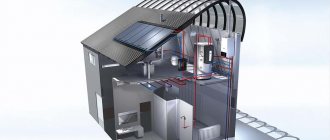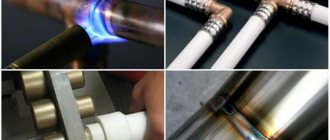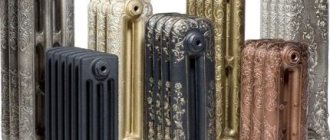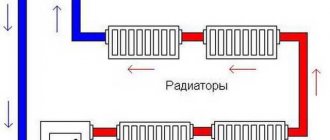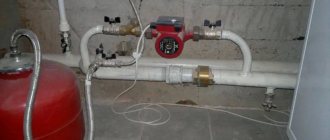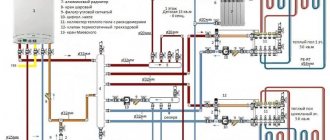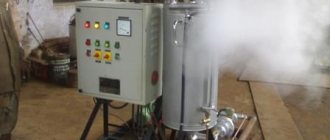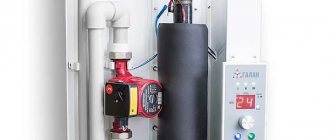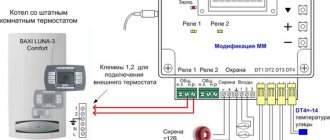The uniform distribution of heat in a house with an autonomous heating system is determined by the model of pumping device used. This equipment ensures the forced movement of a warm medium through pipes and radiators.
To determine which heating pump connection diagram will be optimal for independent implementation, many details must be taken into account. In this article, we will consider in detail possible connection schemes and analyze the connection rules in detail.
We will also pay attention to the subtleties of choosing a location for installation, supplementing the material with thematic photos and diagrams.
Pros and cons of using a heating pump
Just a couple of decades ago, in the private sector, houses were equipped with gravity-type heating. A wood stove or gas boiler was used as a heat source. There was only one area of application left for large circulation devices - centralized heating networks.
Today, manufacturers of heating equipment offer smaller units that have the following advantages:
- The speed of movement of the coolant has increased . The heat generated by the boiler quickly enters the radiators. Due to this, the process of warming up the premises was significantly accelerated.
- The higher the movement speed, the higher the pipe capacity . This means that an identical volume of heat can be delivered to rooms using a pipe with a smaller diameter.
- Water heating schemes have undergone significant changes . The highway can be laid with the slightest slope. Also, the complexity and length of the line can be anything. The basic rule is the rational choice of a heating pump based on the required power.
- With the help of a household circulation device, it became possible to organize heated floors in the house, as well as an effective closed-type heating system.
- It became possible to hide the entire heating communication line passing through the rooms, which does not always go well with the design of the room. Options for laying pipes behind suspended ceilings, in walls or under floor coverings are quite common.
The disadvantages of pumping systems include the dependence of operation on the supply of electricity and its consumption by the pumping apparatus during the heating season.
The leading company Grundfos, engaged in the development of heating equipment, has released innovative models of Alpfa2 circulation pumps, capable of changing performance based on the needs of the heating system, which allows saving on electricity consumption
Therefore, if the area is often deprived of power supply, it would be advisable to install a device to provide uninterrupted power. The second drawback is not critical and can be eliminated by correctly selecting the power and model of the circulation pump.
What is important to know?
The wiring diagram and methods of connecting a device such as a circulation pump to electricity can have different designs. The choice of a specific option is determined by the characteristics of the heated object, as well as the location where the device is located. There are two ways to connect it:
- direct connection to a 220 V power supply;
- connection to an uninterruptible power supply, which in turn is connected to a 220 V or 220/380 V network (in the case of a three-phase UPS).
By choosing the first method, the consumer risks being left without heating in the event of a prolonged power outage. This option can be considered justified only if there is a high degree of reliability of power supply, reducing the likelihood of a long power outage to a minimum, and also if there is a backup source of electrical energy at the site. The second method is preferable, although it requires additional costs.
Selecting the location for inserting the device into the system
The installation of the circulation pump is supposed to be in the area immediately after the heat generator, not reaching the first branch line. The chosen pipeline does not matter - it can be either a supply or a return line.
Where can I put the pump?
Modern models of household heating units, made of high-quality materials, can withstand temperatures of a maximum of 100 °C. However, most systems are not designed for higher heating of the coolant.
The temperature of the coolant in the personal heating network rarely even reaches 70 °C. The boiler also does not heat the water above 90 degrees
Its performance will be equally effective on both the supply and return branches.
And that's why:
- The density of water when heated to 50 °C is 987 kg/m3, and at 70 degrees – 977.9 kg/m3;
- The heating unit is capable of generating hydrostatic pressure of 4-6 m of water column and pumping almost 1 ton of coolant per hour.
From this we can conclude: the insignificant difference of 9 kg/m3 between the statistical pressure of the moving coolant and the return does not affect the quality of space heating.
Are there exceptions to the rules?
As an exception, inexpensive solid fuel boilers with a direct combustion type can serve. Their device does not provide automation, so at the moment of overheating, the coolant begins to boil.
Installation of collector wiring in a heating system using a solid fuel boiler is considered the most effective. However, this type of heating of a private house is one of the most difficult to perform.
Problems begin to arise if the electric pump installed in the supply line begins to fill with hot water and steam.
The coolant penetrates through the housing with the impeller and the following occurs:
- Due to the action of gases on the impeller of the pumping device, the efficiency of the unit decreases. As a result, the coolant circulation rate coefficient is significantly reduced.
- An insufficient amount of cold liquid enters the expansion tank located near the suction pipe. The overheating of the mechanism increases and even more steam is formed.
- A large amount of steam entering the impeller completely stops the movement of warm water along the line. Due to the increase in pressure, the safety valve is triggered. Steam is released directly into the boiler room. An emergency situation is being created.
- If the firewood is not extinguished at this moment, the valve will not be able to cope with the load and an explosion will occur.
In practice, no more than 5 minutes pass from the initial moment of overheating to the activation of the safety valve. If you install the circulation mechanism on the return branch, then the period of time during which steam enters the device increases to 30 minutes. This gap will be enough to eliminate the heat supply.
In inexpensive heat generators made of low-quality metal, the response pressure of the safety valve corresponds to 2 Bar. In high-quality solid fuel boilers - this indicator is 3 Bar
From this we can conclude that it is impractical and even dangerous to install a circulation device on the supply line. Pumps for solid fuel heat generators are best installed in the return pipeline. However, this requirement does not apply to automated systems.
Heating with a group of separate lines
If the heating system is divided into two separate lines, heating the right and left sides of the cottage or several floors, it would be more practical to install an individual pump for each of the branches.
When installing a separate device for the heating line on the second floor, it becomes possible to save money by adjusting the required operating mode. Due to the fact that heat has the property of rising, it will always be warmer on the second floor. This will reduce the coolant circulation rate.
The pump is inserted in the same way - in the area located immediately after the heat generator before the first branch in this heating circuit. Typically, when installing two units in a two-story house, fuel consumption for servicing the upper floor will be significantly less.
Features of the circular
Connecting a pump to an electric boiler is a responsible matter. First, let's look at the features of the device and its operating mechanism. A circular heater is installed for uniform heating of rooms in a private house. It ensures rapid movement of the coolant and helps to quickly raise the temperature in the room. Due to the fact that the unit maintains constant movement of hot water through the pipes, you can save about 20-30% of energy costs to maintain the system.
The device uses blades on a wheel to push the coolant through the pipes. Liquid enters the chamber through a hole in the center. The efficiency of the device can reach 80%. The equipment may break if there is dirt in the water. Therefore, most users install a filter.
The internal structure is quite simple. Inside the housing there is a rotor and a shaft with an impeller. All components are made of stainless material. The rotor is needed to drive the motor. The water that gets inside the device moves further with the help of the blades. Then it enters the system through a spiral channel and the process repeats.
In a short period of time, the equipment is capable of driving a large volume of liquid through pipes. The radiators in all rooms heat up quickly. If pipes with a small cross-section are installed in the structure, this may reduce the performance of the device. Therefore, before purchasing the desired model, you should take into account not only the parameters of the equipment, but also the height of the building, the length of the route and the thickness of the pipeline.
Schemes for different types of systems
Initially, it is necessary to determine the insertion area of the circulation device. With its help, the process of active movement of liquid is carried out - the flow passes through the boiler and is forcibly directed to the heating radiators.
To locate a household pump, it is necessary to determine the most convenient area so that it can be easily serviced. On the supply side, it is installed after the safety block and shut-off valves of the boiler.
In order to carry out maintenance and control the functioning of equipment, it is necessary to install shut-off valves. Thus, any element of the heating system can be removed without completely dismantling the line
On the return pipeline, the pump is placed after the expansion tank in front of the heat generator.
Due to the presence of various mechanical impurities in the water, for example, sand, problems may arise in the operation of the pumping mechanism. Particles contribute to jamming of the impeller, and in the worst case, stopping the motor. Therefore, you will need to install a strainer strainer directly in front of the unit.
The connection diagram for a solid fuel boiler is based on two important elements that allow it to function effectively in the heating system of a private home. These include: a safety group and a mixing unit based on a three-way mixing valve
Separately, it is worth mentioning the issue of an open-type heating system. It is capable of operating in two modes - with forced and gravity coolant circulation.
The second option is more suitable for areas with frequent power outages. This is much more economical than purchasing an uninterruptible power supply or generator. In this case, the unit with shut-off valves must be installed on the bypass, and a tap must be inserted into the direct line.
In stores you can find ready-made units with a bypass. In place of the flow tap, there is a spring-loaded non-return valve. This solution is not recommended - the valve produces a resistance force of 0.1 Bar, which is considered a large indicator for a gravity-type circulation system.
It is better to use a reed valve instead. However, its installation is carried out strictly horizontally.
How to save on energy bills
The heating system design must be drawn up by a qualified specialist. In such a situation, it will be possible to correctly install the unit into the structure and save on heating. If you want to reduce your energy bills, you need to follow these recommendations:
- heating elements should be installed only after carrying out the appropriate calculations;
- if the electric boiler does not have a pump installed, it must be installed in front of the heating unit on the return line;
- it is better to use pipes with a cross-section of at least 32 mm;
- in order not to heat the streets, it is better to insulate the walls;
- Don’t set the appliances to maximum and overheat the room too much;
- you can turn off the heating in certain rooms that are not in use;
- installation of heated floors allows you to consume less energy;
- drafts should be eliminated and ventilation in the rooms should be properly installed.
By following the recommendations described above, the consumer will be able to reduce energy consumption.
Note! If the equipment is correctly selected, an electric boiler will be an excellent alternative to other types of heating.
Solid fuel pump and boiler
The pump is connected to the system with a solid fuel unit on the return line. In this case, the pumping device is connected to the boiler circuit with a bypass and a three-way mixing valve. In addition, the latter can be equipped with a servo drive and an overhead temperature sensor.
The connection diagram for a solid fuel boiler is based on two important elements that allow it to function effectively in the heating system of a private home. These include: a safety group and a mixing unit based on a three-way mixing valve
Due to the fact that the maximum performance of heating equipment is used to its fullest extent only during the cold period, it is possible to install a heat accumulator (TA). It is able to absorb excess heat and then, on demand, release it to the heating circuit.
This battery is made in the form of a tank and is lined with thermal insulation material. On one side of the device there are two pipes intended for connecting it, and two on the other - for connecting to the radiator line.
The heat accumulator has two circuits: small and large. The first one receives energy from the boiler, the second one supplies coolant to the heating system as needed.
As the liquid passes through the boiler, which operates at maximum, the coolant in the heat accumulator warms up over time to 90-110 degrees. In a large circuit, the insertion of another circulation device is required.
Depending on the degree of cooling of the liquid in the heating system, the required amount of heat from the storage device will enter through the valve.
Features of the electric boiler
The diagram for connecting the pump to the electric boiler is simple, but you need to figure out what this device is. In private homes there is no central heating and often gas, so many consumers install an electric boiler.
It is easy to install and connect, and there is no need to build ventilation or a chimney. In the standard model, all parts and components are already installed. The user can install the structure himself without the help of a specialist.
The equipment can convert electrical energy into thermal energy. The following types of units are distinguished: with heating elements, electrode and induction. Each type has its own characteristics. There is a thermostat installed inside that helps control the power of the device and the degree of water heating. All operating data can be obtained using sensors. The design has three operating modes that the user sets for himself.
Remember! If you are not confident in your own abilities, it is better to seek help from the experts. They know the equipment perfectly.
Pump installation diagram
To perform its functions, household circulation equipment, regardless of the manufacturer, must be correctly installed on a pipe or shut-off and control valves.
Fastening is done using union nuts. This fixation option will allow you to remove it if necessary, for example, for inspection or repair.
When choosing a circulation pump model, you need to pay attention to its ability to function in different positions. Vertical placement of the device reduces its power by up to 30%
Correct installation of all elements of the heating system ensures uniform heating of the entire line.
When installing the circulation pump, the following rules must be observed:
- It is allowed to install the device on any section of the pipe. The pipeline can be located horizontally, vertically or inclined. However, the rotor axis must be in a horizontal position. Therefore, installation “head down” or, conversely, up is impossible.
- It is worth paying close attention to the location of the plastic box where the power supply contacts are located - they will be on top of the body. Otherwise, they may be flooded with water in an emergency. To do this, you will need to unscrew the fastening screws on the casing and turn it in the required direction.
- Observe the direction of flow. It is indicated by an arrow on the device body.
With all its weight, the pump presses on the body of the ball valves located nearby. This should be taken into account when choosing fittings. High-quality parts are equipped with a powerful body, which during operation will not become cracked from daily stress.
What is important to know?
The wiring diagram and methods of connecting a device such as a circulation pump to electricity can have different designs. The choice of a specific option is determined by the characteristics of the heated object, as well as the location where the device is located. There are two ways to connect it:
- direct connection to a 220 V power supply;
- connection to an uninterruptible power supply, which in turn is connected to a 220 V or 220/380 V network (in the case of a three-phase UPS).
By choosing the first method, the consumer risks being left without heating in the event of a prolonged power outage. This option can be considered justified only if there is a high degree of reliability of power supply, reducing the likelihood of a long power outage to a minimum, and also if there is a backup source of electrical energy at the site. The second method is preferable, although it requires additional costs.
Installation of additional equipment
Regardless of the type of heating circuit used, where one boiler serves as the heat producer, it will be sufficient to install a single pumping device.
If the design of the system is more complex, it is possible to use additional devices that provide forced circulation of liquid.
An example of a joint wiring diagram for a solid fuel boiler paired with an electric one. This heating system has two pumping devices
This becomes necessary in the following cases:
- when heating a house, more than one boiler unit is involved;
- if there is a buffer capacity in the piping scheme;
- the heating system diverges into several branches, for example, servicing an indirect boiler, several floors, etc.;
- when using a hydraulic separator;
- when the pipeline length is more than 80 meters;
- when organizing water movement in floor heating circuits.
To perform the correct piping of several boilers operating on different fuels, there is a need to install backup pumps.
For a circuit with a heat accumulator, the installation of an additional circulation pump is also required. In this case, the main line consists of two circuits - heating and boiler.
The buffer tank divides the system into two circuits, although in practice there may be more of them
A more complex heating scheme is implemented in large houses with 2-3 floors. Due to the branching of the system into several lines, 2 or more pumps are used to pump the coolant.
They are responsible for supplying coolant to each floor to various heating devices.
Regardless of the number of pumping devices, they are installed on the bypass. In the off-season, the heating system can operate without a pump, which is shut off using ball valves
If you plan to install heated floors in the house, then it is advisable to install two circulation pumps.
In the complex, the pumping and mixing unit is responsible for preparing the coolant, i.e. maintaining the temperature at 30-40 °C.
In order for the power of the main pumping device to be sufficient to overcome the local hydraulic resistance of the floor contours, the length of the line should not be more than 50 m. Otherwise, the heating of the floors will become uneven and, accordingly, the rooms
In some cases, the installation of pumping units is not required at all. Many models of wall-mounted electric and gas generators already have built-in circulation devices.
Selection of electric boiler
Electric boilers are installed quite often. In most cases they act as a reserve. Often consumers use gas or solid fuel. But sometimes, if the appropriate equipment is available, the electric boiler is used as the main one. To correctly decide which structure to install in the house, you need to consider the following points:
- if the house is poorly insulated, you need to install a structure with a power of 10 kW per 100 sq. m;
- for buildings built using energy-saving technology, such power is not needed;
- if the building is very cold, then it is better to buy a device with a power of 20 kW per sq. m.
Remember! It is more rational to insulate the house than to purchase more powerful equipment.
You can see how to choose the right boiler model in the video
How to connect a circulation pump to an electric boiler was discussed earlier. In order for the device to work without failures, it must be connected correctly. During installation, the following rules must be observed:
- use wires of a certain type with copper veins of the required cross-section;
- You only need to connect whole pieces of wire, not pieces;
- Additional equipment cannot be used to constantly turn on and off; all elements must be installed in the circuit;
- It is necessary to install leakage sensors and overcurrent protection.
Rules for connecting to power supply
The circulation pump is powered. The connection is standard. It is recommended to install a separate power supply line with a surge protector.
To connect, you need to prepare 3 wires - phase, neutral and ground.
You can choose any of the connection methods:
- through a differential machine device;
- connection to the network together with an uninterruptible power supply;
- power supply to the pump from the boiler automation system;
- with thermostat regulation.
Many people wonder why complicate things, because connecting the pump can be done by connecting a plug to a wire. This is how the pumping device is plugged into a regular outlet.
However, experts do not recommend using this method due to the risk of unforeseen situations: there is no grounding and a safety device.
A circuit with a differential machine is used for so-called wet groups. A heating system constructed in this way ensures a high degree of safety for wiring, equipment and people.
The first option is not difficult to assemble yourself. It is necessary to install an 8 A differential circuit breaker. The wire cross-section is selected based on the device rating.
In the standard scheme, the power supply is carried out to the upper sockets - they are marked with odd numbers, the load - to the lower ones (even numbers). Both phase and neutral will be connected to the machine, so the connectors for the latter are designated by the letter N.
To automate the process of stopping the circulation of the coolant when cooling to a certain temperature, an electrical circuit is used to connect the pump and thermostat. The second is mounted in the supply line.
At the moment when the water temperature drops to the specified value, the device disconnects the electrical supply circuit.
In order for the thermostat to turn off the circulation process at the right time, it is installed on a metal section of the pipeline line. Due to poor heat conductivity of polymers, installation on a plastic pipe will result in incorrect operation of the device
There are no difficulties in supplying electricity through an uninterruptible power supply; it has special connectors for this. A heat generator is also connected to them when there is a need to provide electricity.
If you choose the method of connecting the pump to the boiler control panel or automation, you will need good knowledge of the power supply system or the help of a professional.
Troubleshooting
Based on how the pump operates, sound, vibration or changes in pressure, outlet pressure, it is necessary to accurately determine the malfunction and eliminate the cause.
| Symptom of malfunction | Probable Cause | Repair |
| The pump makes sounds after switching on, but the shaft does not rotate | Shaft oxidation due to prolonged inactivity | Unscrew the protective cap from the end of the shaft on the motor housing and manually turn the motor shaft using a slotted screwdriver. |
| Blocking by a foreign object | Disassemble the pump block with the impeller and clean it, check the condition of the coarse filter installed in front of the pump | |
| Power problems | Check the voltage rating in the network and correct the problem if necessary. | |
| After applying voltage, the pump does not start and does not make any sounds. | No actual voltage on power line | Check the power line and the condition of the circuit breakers |
| The fuse in the control unit has tripped | Replace fuse | |
| The pump turns off after a short period of operation | Limescale deposits in the stator cup | Clean the stator cup and motor rotor |
| Strong extraneous noise when the pump is running | Dry running, presence of air in pipes | Release the air. Drain the pump shell and fill with water. |
| Cavitation | Increase the pressure in the supply line. | |
| Pump vibration | Support bearing wear | Replacing bearings |
| Reduction of pressure and flow in comparison with the passport data | Abnormality in the power supply to the pump, phase change, resulting in a decrease in pump power or a change in the direction of rotation of the impeller | For three-phase motors, the quality of all phases is checked. For single-phase power supply, check the capacitor and replace if necessary |
| High hydraulic resistance of the circulation circuit | Check the filters, increase the cross-section of the pipes, check the condition of the shut-off valves. | |
| Triggering of external protection on the pump power line | Problems with the electrical part of the pump | Check the condition of the terminals for short circuits, check the capacitor and the control unit. Check the stator windings. Their resistance should not be lower than the rated value. |
Briefly about the main thing
The circular valve helps the liquid move faster through the pipes. It is installed to heat the room faster. If you are not confident in your own abilities, it is better to invite a specialist to connect the heating elements. An electric boiler is a good alternative for heating a private home if there is no gas or solid fuel. In order for the device to operate without failures, you must follow the connection instructions during installation. If you want to reduce your utility bills, you need to insulate the walls and not set the temperature in the rooms to maximum. Many users are interested in how to connect a circulation pump when the network is disconnected. To do this, the device is mounted on the bypass. When the lights are turned off, the liquid moves through the radiators by gravity.
How difficult do you think it is to independently connect pumping equipment to an electric boiler?
Source of the article: https://makipa.ru/stati/cirkulyacionnye-nasosy/podklyuchenie-cirkulyacionnogo-nasosa-k-elektrokotlu-algoritm/
